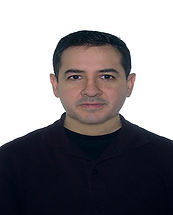Enhanced Oil & Gas Recovery and Reservoir Characterization


Jose Ramon Mayorquin
PhD (2015)
Current position: PEMEX
Research topic: Lab to Field Scale Modeling of Low Temperature Air Injection with Hydrocarbon Solvents for Heavy-Oil Recovery in Naturally Fractured Reservoirs
Alternatives for enhanced oil recovery processes in heavy oil containing deep naturally fractured reservoirs (NFR) are limited due to excessive heat losses when steam is injected. Air injection at high temperature oxidation conditions (in-situ combustion) has been considered as an alternative to aqueous based thermal applications. However, its implementation has serious limitations including poor areal distribution of injected air and poor combustion efficiency due to the heterogeneous nature of these reservoirs as well as the safety risk of unconsumed injected oxygen (O2) reaching the production wells. Taking advantage of the low cost and availability of air, one option is to use air at low temperature conditions (low temperature oxidation, LTO) as a pressurizing agent in NFR. Oxygenated compounds are generated at these conditions resulting in oil viscosity increase, reducing fluid mobility. In order to minimize this detrimental effect, a combination of air injection with hydrocarbon solvents can be applied.
The objectives of this research are to evaluate air injection at LTO conditions in NFR containing heavy oil as a way to improve oil recovery, to clarify the effect of hydrocarbon solvent addition into air on oil recovery and O2 consumption, and to propose optimal conditions (temperature, air/solvent ratio) and implementation strategies for an efficient use of this suggested method. Comprehensive laboratory and numerical simulation studies were conducted to achieve these objectives. Static diffusion experiments—simulating cyclic gas injection (huff-and-puff)—were carried out by soaking heavy oil saturated cores into a reactor filled with gas representing a matrix/fracture system.
Oil recovery and O2 consumption were the main parameters assessed and an extensive set of variables including rock type, temperature, fracture volume, solvent type, matrix size, gas injection sequences, and soaking times were studied. From experimental studies, the following conclusions were made: 1. Gas sequence design affects oil recovery, 2. O2 consumption in air cycles is higher after the core is soaked into butane rather than propane, 3. It is beneficial to soak cores in air+C3 mixture rather than pure air or solvent; i.e., lower O2 concentration in produced gas, less solvent usage, higher and faster oil recovery compared to alternate injection of air and C3.
Then, core scale numerical simulation models were created for modeling lab experiments for a sensitivity analysis on Air/C3 ratio and matrix size. The results show that the process is extremely sensitive to matrix size and optimization of air injection (assisted by hydrocarbon solvents) can be achieved based on the minimized hydrocarbon solvent for a given matrix size. Additionally, a sensitivity analysis was performed using an up-scaled numerical model to the field scale containing meter-scale matrix blocks. It was observed that oil production mechanisms acting in a matrix block surrounded by gas filling the fractures are predominantly gas-oil gravity drainage, effective diffusion, and voidage replacement of oil by gas.
Finally, a numerical simulation sector model of a hypothetical NFR was created and several airgas injection sequences were analyzed. It was concluded that injection of air (LTO conditions) and propane represents an alternative for heavy oil recovery from NFRs at the field scale, and an optimum production time/soaking time ratio can be obtained for given gas injection sequences (type of gas and injection/soaking durations), temperature, and block sizes.
Publications:
-
Mayorquin, J. and Babadagli, T.: “Low Temperature Air-Solvent Injection for Heavy Oil Recovery in Naturally Fractured Reservoirs” J. of Canadian Petr. Tech., vol. 54, no. 3, 148-163, 2015 (May).
-
Mayorquin, J. and Babadagli, T.: “Optimal Design of Low Temperature Air Injection with Propane for Efficient Recovery of Heavy Oil in Deep Naturally Fractured Reservoirs: Experimental and Numerical Approach,” Energy and Fuels, vol. 30, no 4, 2662-2673, 2016.
-
Mayorquin, J. and Babadagli, T.: “Low Temperature Air Injection with Solvents in Heavy-Oil Containing Naturally Fractured Reservoirs: Effects of Matrix/Fracture Properties and Temperature on Recovery,” Fuel, vol. 179, 376-390, Sept. 2016.
-
Mayorquin, J., Babadagli, T. and Rodriguez de la Garza, F.: “Field Scale Numerical Modeling of Low Temperature Air Injection with Propane for Heavy-Oil Recovery from Naturally Fractured Reservoirs,” Fuel, vol. 160, 140-152, 2015.
-
Mayorquin, J. and Babadagli, T.: “Can Injection of Low Temperature Air-Solvent (LTASI) Be a Solution for Heavy Oil Recovery in Deep Naturally Fractured Reservoirs?,” SPE 153997, 2012 SPE EOR Conference at Oil and Gas West Asia, Muscat, Oman, 16-18 Apr., pp. 18.
-
Mayorquin, J. and Babadagli, T.: “Optimal Design of Low Temperature Air Injection for Efficient Recovery of Heavy Oil in Deep Naturally Fractured Reservoirs: Experimental and Numerical Approach,” SPE 149896, 2012 SPE Heavy Oil Conference, Calgary, Canada, 12-14 June, pp. 17.
-
Mayorquin, J., Babadagli, T. and Rodriguez de la Garza, F.: “Low Temperature Air Injection at the Mature Stage of Deep Naturally Fractured Heavy-Oil Reservoirs: Field Scale Modelling,” Paper PAMFC15-141, 2015 Pan American Mature Field Congress, Veracruz, Mexico, 20-22 Jan.
